Earlier this year I published a book on writing a winning research proposal. Today, I turned much of the book’s advice into a ChatGPT that is tailored for automatically writing a research proposal. It works amazingly well.
To enable my custom-made “Research Proposal Writer” GPT prepare a research proposal, the user only has to upload a picture of a Research Project Canvas into ChatGPT and voilà – out comes a written research proposal, divided into the nine sections of a typical research proposal.
In this post, you will see exactly how it works, I will show an example in a video, and you can certainly try the tool yourself. But first, let’s back up a little. Let me first tell you what a GPT and Research Project Canvas are exactly.
What is a GPT?
Unless you have been living on a different planet, you know what ChatGPT is. Like many, I was impressed by the technology and have played around with it multiple times.
I once tried using ChatGPT for writing a research proposal but I was not impressed. It could not come up with text in a way that was helpful to me, even if I tried using advanced prompts, defined the persona, described the language style and did other fancy things. Sure, it could paraphrase text, convert text into bullet points, and perhaps write an abstract if I uploaded the full proposal text but it could not do much more. I found that I can not profit from it much and stopped using ChatGPT for writing research proposals.
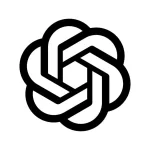
Then on November 6, 2023 OpenAI (the company behind ChatGPT) released a new way ChatGPT can be used – called GPTs. This changed everything. A GPTs can be tailored for a specific purpose. It’s like a custom version of ChatGPT that is made for doing one particular thing.
Of course, I came back to my idea of using it for writing a research proposal. Now I could teach the ChatGPT to automatically follow the proposal writing advice from my book “Write a Winning Research Proposal”. And the custom GPT was perfectly adapted for using the core concept of the book, the “Research Project Canvas”.
What is Research Project Canvas?
Research Project Canvas is a one-page template that holds nine blocks corresponding to key parts of a research proposal, including objective, methodology, resources, etc. A scientist uses sticky notes to outline the key contents of the planned research project on the Project Canvas. This brevity allows conceiving many alternative ideas, discarding the doomed ones, and further refining the good ideas.
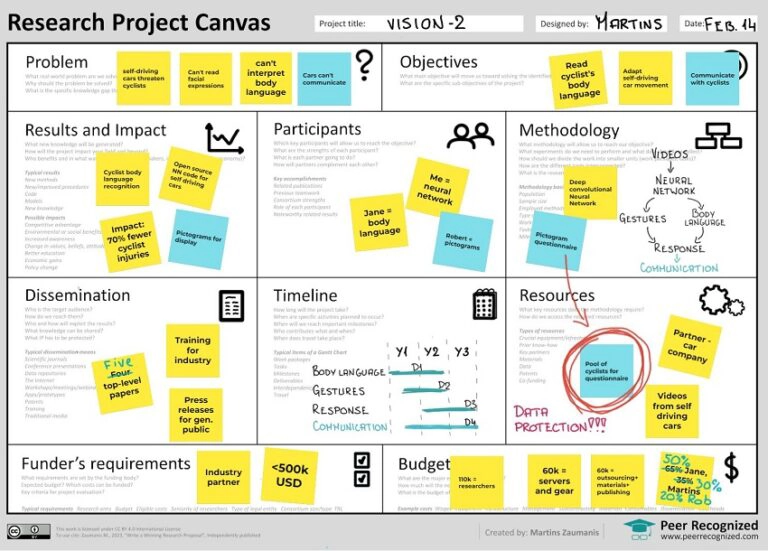

The premise of my book is that with a filled Research Project Canvas in hand, the task of writing a proposal is less intimidating since the core concept of the proposal is already developed. The scientist only needs to convert the sticky notes into a full proposal. Except – the ChatGPT can now do it for you.
ChatGPT for writing a Research Proposal
It doesn’t take a genius to see how a tailored GPT could use the Research Project Canvas to write the first draft of the proposal. So as soon as the GPTs were announced, I started building a custom GPT that allows converting a research idea into a research proposal. I defined the language my GPT should use, the writing style and some other things to make it would write like an experienced researcher.
Most importantly, I defined the structure or a research proposal, the section headings, and the scientific content that each section of a research proposal should hold.
Then I trained the GPT to recognize what the Research Project Canvas is and showed it how to read each of the Canvas’s blocks.
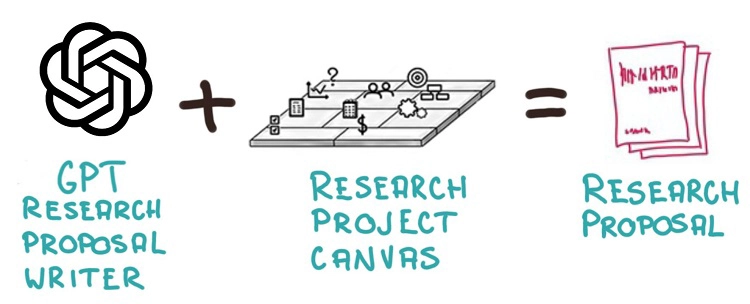
The result: you only need to upload a single picture of a Research Project Canvas into the “Research Proposal Writer” and voilà – Chat GPT writes the research proposal. The GPT describes project in nine sections of a typical proposal – the research problem, objectives, methodology, dissemination, etc. Everything is based on the project idea you upload using the Research Project Canvas.
How the GPT works
I programmed the GPT to stick closely to the idea in the research project canvas. I wanted it to write a proposal on the user’s idea, rather than coming up with it’s own ideas. So be aware – if the Research Project Canvas is short on information, the ChatGPT will not write a lengthy proposal. If something is unclear, it will ask you to clarify.
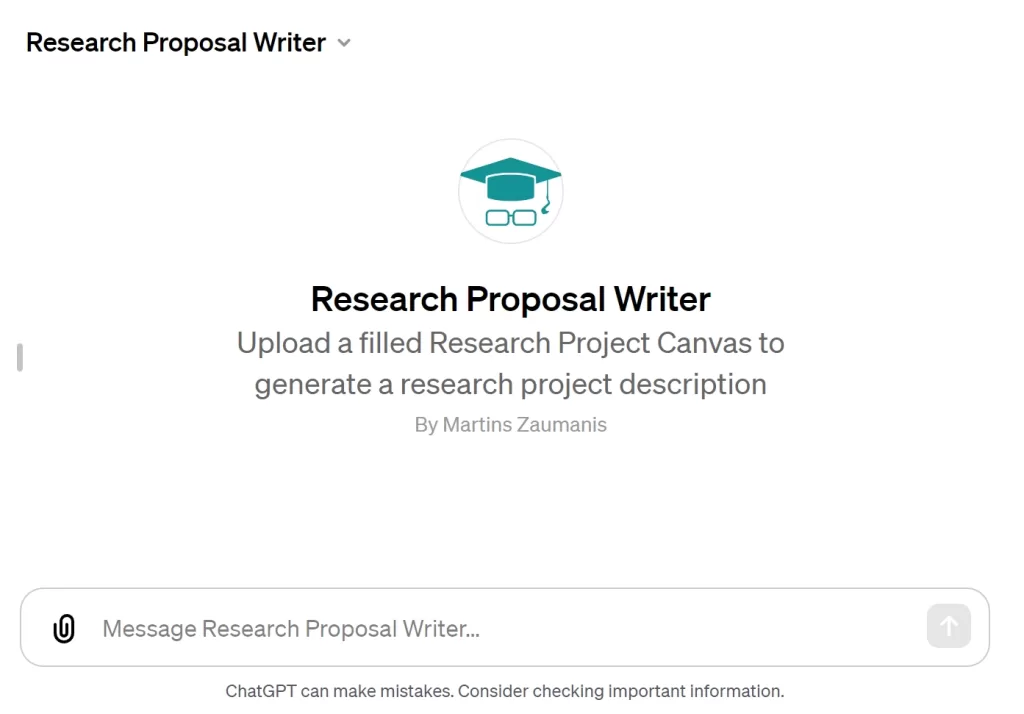
After lengthy testing, it also seems to me that if the idea described in the Research Proposal Canvas is niche – the generated proposal will be shorter. While if a lot of information can be found on the topic, the “Research Proposal Writer” will come up with a longer proposal. It makes sense – after all the Large Language Model that ChatGPT uses is based on training from the web. If there is a lot of information on the topic – it knows better what to write.
Once you upload the Research Project Canvas and click “Send”, the ChatGPT will offer an outline of the research proposal. You can review the outline and if something is not exactly like you want – ask to change it.
Next, tell the GPT to “Write a full proposal”. It will do so section by section – giving you the chance to edit. After you are happy with the section, write “Continue”.
Once the project proposal is finished, I made it do two last things: write an abstract and create a logo. Just like when a human writes a proposal, creating these is better left to after everything else is done. Now that the proposal content is defined the GPT knows better how to summarize it in an abstract and what to include in the logo. The logo is generated using DALL-E2.
Case study: GPT Generates a Research Proposal
Below you see the end result, generated by the Research Proposal Writer GPT. It’s a 3,405-word research proposal on an imagined project dealing with the interaction between cyclists and self-driving cars. It is the same example I used in my book on proposal writing.
The generated research proposal draft is by no means perfect. It lacks technical details, the descriptions are sometimes mundane, and certainly I would not trust the references it provides. But the ChatGPT did a hell of a job converting a few bullet points on sticky notes into a meaningful proposal.
This “Research Proposal Writer” GPT beats my previous attempts at using ChatGPT for writing research proposals by a mile. And all it took was an upload of one photo of the Research Project Canvas.
Never trust the proposal generated by the “Research Proposal Writer”. Use this just as the starting point of your proposal. Edit it and then keep building upon it until the project is described exactly like you want.
Take care when uploading sensitive information to ChatGPT
It’s important to stress that the “Research Proposal Writing Assistant” did not come up with the idea for the proposal. The research idea is developed by the researcher and uploaded to the GPT using the Research Project Canvas. This is a cause for worries.
OpenAI (the company behind ChatGPT) is a private company. It will use the information you upload for creating the proposal description but it may use it also for other purposes. I suggest not to upload any sensitive data into the program. And certainly review the privacy policy for ChatGPT use. I un-ticketed the box which allows ChatGPT to use the data from the conversation for training its models but whether to trust them is up to you.
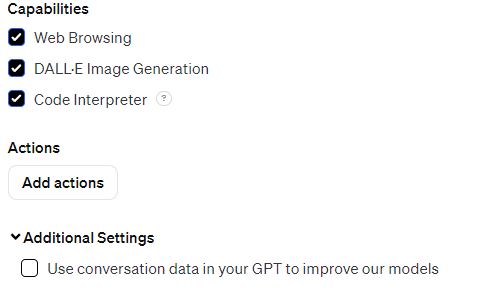
Just to make it clear: I do not see what you upload into the Research Proposal Writer, I don’t see your conversation, and I don’t see the answers that ChatGPT generates for you.
Video of the ChatGPT Research Proposal Writer in action
Try the “Research Proposal Writing Assistant” GPT
You can access the Research Proposal Writer GPT using the link below. I am very curious so see how useful you find the tool. Please write me once you have tried it out: [email protected].
To use the tool, you will need two things:

Disclaimer: use the tool at your own discretion. Check the privacy rules with ChatGPT and OpenAI
Scientists need not apply?
For now, I am happy that the GPT does much of the work I dread. I am left with the things I love about dreaming up research projects: coming up with research ideas. I can leave much of the initial burden of writing the proposal to the GPT.
As the technology evolve, the tool will become even better.
However, this rises some tough questions:
Now scientists will be able to write a nearly infinite number of proposals. This could clog review process of the research funding agencies. Clearly, it will be almost impossible to forbid the use of AI for writing proposals. I imagine one of the solutions in the future might be to employ AI to do part of the review process. Besides the privacy issues that uploading a proposal to a private AI company rises, this poses an ethical question too: if AI is reviewing a proposal that was generated by AI, why bother with the middle man – the scientist?
I actually created a custom GPT for reviewing research proposals. Access it here.
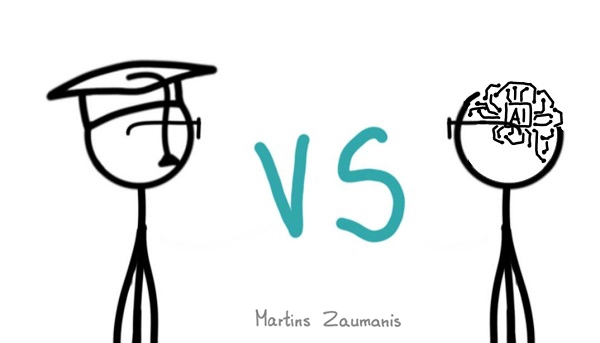
Do we need the detailed proposals at all? Could we just use some brief summary of the planned research (like the Research Project Canvas) for evaluating proposals? This, after all, was the core creative value that I created by putting my ideas and research methodology in it.
Oh, but wait… the Research Project Canvas is a simple template and surely the ChatGPT can generate text to fill it. I actually tried it. The content was not very sophisticated and an expert reviewer would spot it. It is also probably not unique because ChatGPT uses training data to come up with the answers, meaning that someone might have done something similar already.
But what happens if we connect the AI to scientific literature and ask to identify gaps in the scientific knowledge? Undeniably, this can result in some very useful research topics. What is the role of the creativity of a scientist in this process? We could become relegated to mare executors of ideas that one AI comes up with and a different AI approves. In other words – do scientists still need not apply?
It used to be that the burden of writing a research proposal would limit the number of proposals a scientist can submit. It used to be that the thoroughness in which research proposal is written shows demonstrates the capabilities of its authors. That’s becoming less of the case with the advancements of AI language models.
Scientists do need to apply, of course. AI in the form of large language models is just that – a tool that generates text. It doesn’t possess expert knowledge, it doesn’t think critically, it has bias towards the data that was used for training, it can not evaluate the novelty of a research idea.
What the future holds
I think the use of AI will make the job of research proposal reviewers even more important. Reviewers will need to spot and support truly great ideas, rather than just the most coherent proposal. If not – rather than awarding the best scientists with the best ideas, soon we will be awarding research grants to people who can program a more advanced AI version for writing a research proposal.
Besides, there are very real concerns the use of AI creates, including the energy use for running the models, plagiarism and many other things. But that’s a topic for another article.
ChatGPT will not get you a grant – not yet
ChatGPT is still inferior to a scientist writing a research proposal. To write a winning research proposal, you have to know how to add that elusive X-Factor that convinces the reviewers to move your proposal from the category “good” to the category “support”. This includes creating self-explanatory figures, creating a budget, collaborating with co-authors, and presenting a convincing story.
To maximize your chances of receiving research funding, read my book “Write a Winning Research Proposal“.
This isn’t just a book. It’s a complete research proposal writing toolkit that includes a project ideation canvas, budget spreadsheet, project rating scorecard, virtual collaboration whiteboard, proposal pitch formula, graphics creation cheat sheet, review checklist and other valuable resources that will help you succeed.
Author

Hey! My name is Martins Zaumanis and I am a materials scientist in Switzerland (Google Scholar). As the first person in my family with a PhD, I have first-hand experience of the challenges starting scientists face in academia. With this blog, I want to help young researchers succeed in academia. I call the blog “Peer Recognized”, because peer recognition is what lifts academic careers and pushes science forward.
Besides this blog, I have written the Peer Recognized book series and created the Peer Recognized Academy offering interactive online courses.

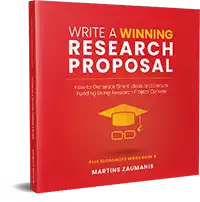

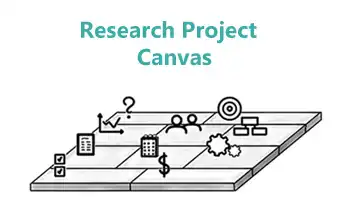



One comment